Symbols of Electric Components
- Books Name
- CBSE Class 7 Science Book
- Publication
- Param Publication
- Course
- CBSE Class 7
- Subject
- Science
ELECTRICITY :
It is the branch of physics which deals with the study of interaction of one charge to the another charge. It can be divided into two part :
(i) Static Electricity (ii) Current Electricity
(a) Static Electricity : The branch of physics which deals with the study of the electric charges at rest and their effects is known as electrostatic or static electricity.
(b) Current Electricity : The branch of physics which deals with the study of the electric charges in motion and their effects is known as current electricity.
Use of Electricity : We use electricity for many purposes to make our tasks easier. For example, we use electricity to operate pumps that lift water from wells or from ground level to the roof top tank. Electricity makes it possible to light our homes, roads, offices, markets and factories even after sunset. This helps us to continue working at night.
Source of Electricity: Mainly two types of Sources of Electricity
1. Power Station : It is a Main Source of Electricity. It produces and supply huge amount of Electricity. All the high voltage equipment get the supply from power station.
2. Electric Cells (Batteries) :It gives little amount of Electricity. It is portable and safe.
SYMBOLS OF ELECTRIC COMPONENTS :
The following are the symbols for some electric circuit components.
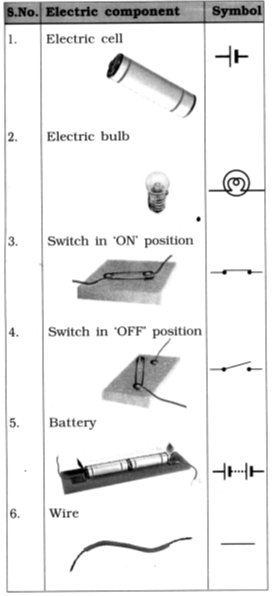
ELECTRIC CHARGE :
From the study of atomic structure we know that an atom consists of a central part called nucleus and around the nucleus (called extra-nucleus) there are a number of electrons revolving in different paths or orbits. The nucleus consist of protons and neutrons. A proton is a positively charged particle while a neutron has no charge. Therefore, the nucleus of an atom bears a positive charge. An electron is a negatively charged particle having magnitude of negative charge equal to the magnitude of positive charge on a proton. Normally, the number of electrons is equal to the number of protons in an atom. Therefore, an atom is neutral as a whole, the negative charge on electrons cancelling the positive charge on protons. This leads to the conclusion that under ordinary conditions, a body is neutral, i.e. it exhibits no charge. When a body has deficiency or excess of electrons from the normal, it is said to be charged or electrified.
Heating Effect of Electric Current
- Books Name
- CBSE Class 7 Science Book
- Publication
- Param Publication
- Course
- CBSE Class 7
- Subject
- Science
EFFECT OF ELECTRIC CURRENT :
(a) Heating Effect of Electric current :
As you know, electric currents flow through a conductor. This flow experiences some resistance from the conductor. As a result some electricity changes into heat energy. Copper and aluminium offer very small amount of resistance. So, when electric currents flow through them, they produce very small amount of heat. Tungsten and nichrome offer a large resistance.
When electric current pass through them, they produce a large amount of heat. Heating effect is used in electric iron, electric heater, electric toaster, electric kettle, electric oven, geyser, etc. When electric current is passed through the heating element of these devices, heat is produced.
Example :
(i) Electric Heater :
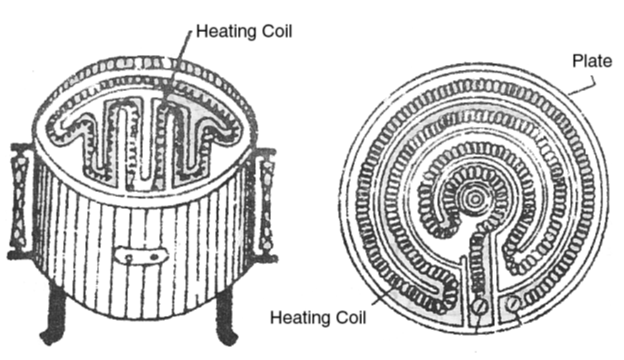
(ii) Electric Iron :
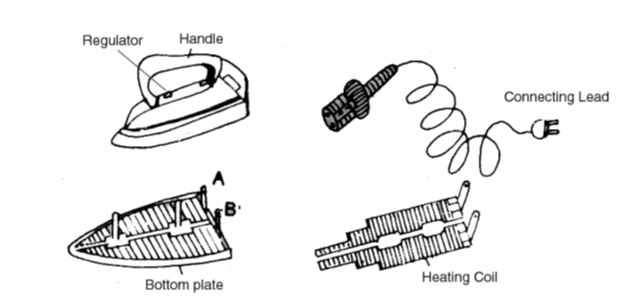
The amount of heat produced in a wire depends on its material, length and thickness, Strength of the electric current. Thus, for different requirements, the wires of different requirements, the wires of different materials and different lengths and thicknesses are used.
The filament of an electric bulb gets heated to such a high temperature that it starts glowing.
Electric fuse :
Fuse
A fuse is a small piece of wire made of lead and tin It is a safety device which limits the current in an electric circuit and prevent short circuits. It is placed in the live wire at the entry point of the current. If the current in a circuit exceeds a specified value, the fuse wire melts and breaks the electric circuit.
The common type of fuse consists of a porcelain holder fitted with metallic terminals. The fuse wire is screwed between these terminals. The holder fits into a porcelain socket provided with a live wire. When the holder is in position, current will flow in the circuit.
Characteristics of a Fuse
• It has a short length wire with a low melting point. The fuse wire is made of an alloy containing equal amounts of lead and tin. It melts at about 200°C.
• Fuse wire has higher resistance and its temperature rises much faster than the connecting copper wire in case of overload.

Fuse wire in an electric circuit
Miniature circuit breaker (MCB)
A miniature circuit breaker (or MCB) is an alternative arrangement for fuse. The main problem with fuses is that whenever a fuse wire blows up, it needs immediate replacement. But in an MCB, we need not to face such a problem. It is placed in series in a given electric circuit. If the current exceeds the specified value, the MCB trips, i.e., puts off the switch and thus, the electric supply is cut off. It can be reset after correcting the fault.
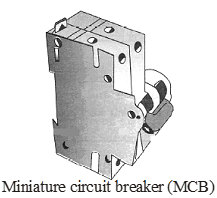
Fuses of different rating are used for different purposes. It can be of 1 ampere, 2 ampere, 3 ampere and 5 ampere.
Short and Overload Circuit :
Now imagine in a circuit, if a 2000 W room heater is used. It will draw a large amount of current. This in turn will heat the connecting copper wires to such an extent that plastic insulation on them will melt. Now the bare wires will come in contact with one another. This will cause electric sparking and hence an electric fire. Such a circuit is called overloaded circuit and the sparking which causes fire is due to short circuit.
Overload in an electric circuit, therefore, is a condition when it draws more current than it is designed for. Short circuit occurs when a naked live wire and a neutral wire come in contact, by passing the electric device in the circuit which in turn, occurs due to overload or the connection of the live wire with the earth wire.
Short circuiting causes a greater loss of property and life every year in the homes and factories.
Hence a fuse is the weakest part in an electric circuit, which melts and breaks the electric circuit when the circuit gets overloaded.
(i) Due to a large current
(ii) Due to short circuiting
(iii) Due to fluctuations of current in power supply system
So it may be prevented by proper uses of fuse.
(b) Chemical Effect of Current (Electroplating)
When an electric current is passed through water containing sulphuric acid, the water breaks up into its components hydrogen and oxygen. Therefore an electric current can cause a chemical change. This effect of electric current is used in electroplating . Electroplating :The method of plating one metal object with another metal by means of electricity is called electroplating. The metal which is to be electroplated is made cathode and the metal to be deposited is made anode while the soluble salt of the same metal serves as the electrolyte. When a current is passed, a thin film of metal is deposited on the metal, which becomes electroplated.
Eg. : Let we are having a steel razor blade is to be electroplated with copper.
3. To show the heating effect of current on a bulb :
• Insert a bulb between the cell and the conducting copper wire as shown in figure.
• What do you observe after a few minutes? Does the end of the copper wire become warm again? No, why has the temperature not gone up? Now touch the bu'lb. Do you observe any heating effect?
You will observe that the temperature at the ends of the copper wire remains unchanged but the glass of the bulb gets heated.
The heating of the bulb in this activity shows the heating effect of current on the bulb.
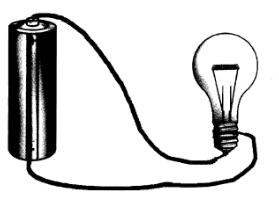
4. To show heating effect of current on nichrome :
Take a 5 cm long nichrome wire, make a loop of it and connect it to a battery of two cells with the help of copper wires as shown in figure. Note your observations.
You will observe that the loop of nichrome wire gets red hot.The electrical energy changes to heat energy and therefore the wire gets red hot.
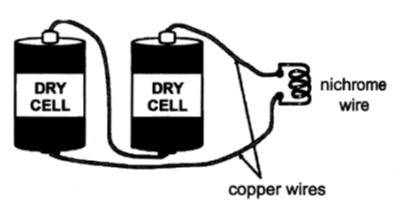
Magnetic Effect of Electric Current
- Books Name
- CBSE Class 7 Science Book
- Publication
- Param Publication
- Course
- CBSE Class 7
- Subject
- Science
(c) Magnetic effect of electric current
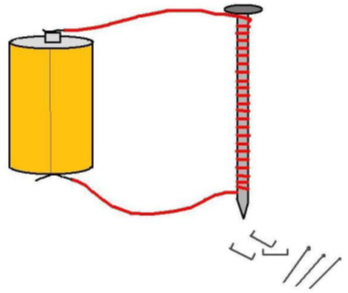
According to Hans Christian Orested, magnetic effects are associated with current. It means, when electric current passes through a wire, it behaves like a magnet. This is the magnetic effect of the electric current.
(i) Magnetic field 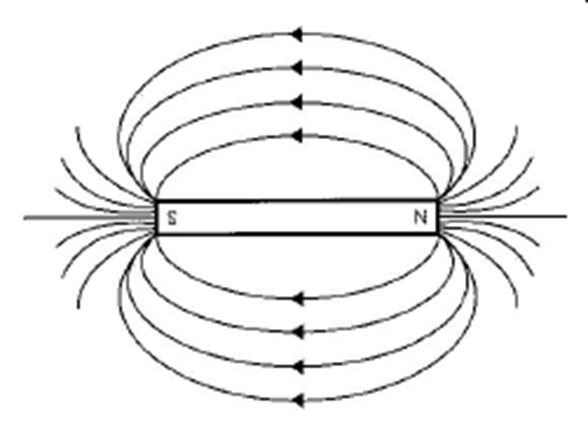
Let us take a card board tray through which a straight wire is passed in which current is passed. If some iron fillings are kept on to the card-board, it will arrange itself in concentric circles around the wire. Which shows that magnetic field is developed, when current is flowing in the wire.
In the same way, when a compass needle is placed below a current carrying conductor it deflects in a specific direction and if the direction of current changes, the direction of deflection in the compass needle also changes. That means a moving magnet can generate an electric current. Also we can say that electric current can produce a magnetic effect.
5. To show magnetic effect of electric current :
• Take a small piece of cardboard, make two holes and pass a wire through them.
• Now put a magnetic compass under the wire and rotate the cardboard till the needle of the compass comes parallel to the wire as shown in figure (a).
• Now connect the two free ends of the wire to the two terminals of a cell as shown in figure (b).
• Note your observation. Is there any deflection in the compass needle?
• Now change the connections of the wire with the cell by reversing the terminals and observe the direction of deflection. What happens when you disconnect or break the circuit?
The compass needle shows deflection when connected to the cell. This deflection gets reversed when the connection is reversed. There is no deflection upon disconnection.
The experiment shows that when electric current is passed through a conducting wire, it behaves like a magnet.
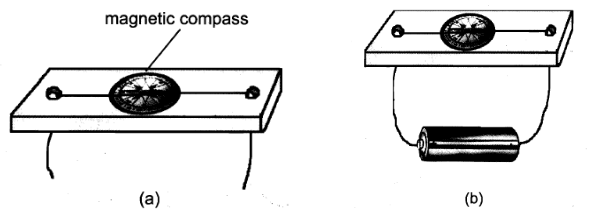
6. To show that a magnetic field is Introduced via electric current :
You have already seen in Activity , that the compass needle deflects on passing electric current through the wire. Now loop a long wire around the compass several times as shown in figure and pass the electric current.
You will see stronger deflection in the compass needle.
The needle of the compass shows higher deflection because of the increase in number of rounds of wire around the compass.
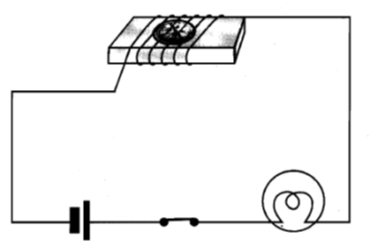
7. To show that the intensity/magnitude of the magnetic field increases with the increase in current intensity.
Use the arrangement of the earlier activity and connect the conducting wires to a battery of three cells of
1.5 Veach as shown in figure. Do you observe any change in the deflection of compass needle? Why?
The enhanced deflection in the compass needle is due to increase in the current density available through a battery of these cells of 1.5 Veach.
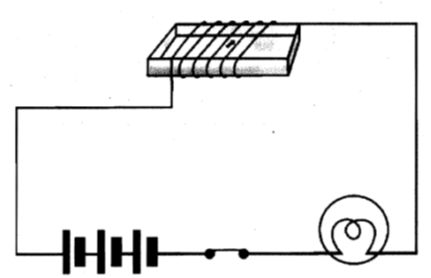
Electromagnet
- Books Name
- CBSE Class 7 Science Book
- Publication
- Param Publication
- Course
- CBSE Class 7
- Subject
- Science
(ii) Electromagnet
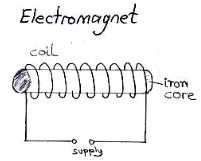
When the current carrying coil is brought near a suspended bar magnet one side of the coil repels the north pole of the magnet. The otherside of the coil attract the north pole of the magnet. Thus, a current carrying coil has both north and a south pole like a magnet. Such a magnet is called electromagnet.
The electromagnet can be made very strong and can lift very heavy loads. The electromagnets are also used to separate magnetic material from the junk. Doctors use tiny electromagnets to take out small pieces of magnetic material that have fallen in the eye. The most common use of electromagnet is electrical bell.
Factors which effect the strength of electromagnet :
(A) magnetic effect of current depends on number of turns.
(B) magnetic effect of current depends on the value of current.
(C) magnetic effect of current depends on the nature of core inside the coil.
8. To make an electromagnet.
• Take an iron nail of about 6-10 cm in length and wind an insulated copper wire on it
• Now connect the ends of the copper wire to the two terminals of a dry cell via a switch.
• Switch on the current through the circuit and bring a few iron pins near the wounded nail.
• Now switch off the current and see what happens.
The iron nail behaves like a magnet as long as current flows through the circuit. The pins cling to the nail when the switch is 'on' while they drop as soon as the switch disconnects the electric circuit. You can see an enhanced magnetic field (more pins cling to the nail) if you use a battery in place of a cell.
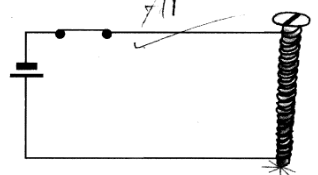
Electric Bell.
- Books Name
- CBSE Class 7 Science Book
- Publication
- Param Publication
- Course
- CBSE Class 7
- Subject
- Science
ELECTRIC BELL :
An electric bell is the most common application of electromagnets. It consists of an electromagnet, a springy iron strip, a hammer, a gong, twoswitches and connecting wires.
Construction :
(i) Electromagnet: A coil of wire wound on an iron core acts as an electromagnet, when current is applied.
(ii) Armature: An armature with a hammer at one end is kept close to the electromagnetic facing its poles.
(iii) Interupter: To make the bell ring continuously, a device is needed to keep the hammer moving back and forth. This devide is called an interrupter.
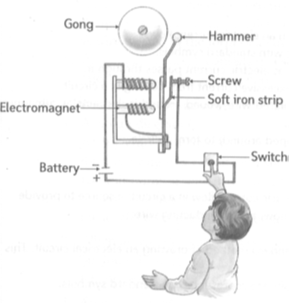
Working of Electric bell :
Step 1: When you push the switch of the bell, the electric current flows to the electromagnet.
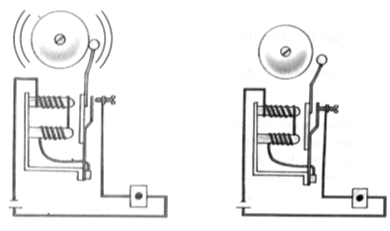
Step 2: The electromagnet attracts the soft iron strip. The hammer attached to the strip then hits the gong, causing a ring.
Step 3: When the soft iron strip gets attracted to the electromagnet, it no longer touches the screw (interrupter) and hence the circuit is broken, (much like a switch being turned off). This turns off the electromagnet and it can no longer attract the soft iron strip. The soft iron strip returns to its initial position, touching the screw (interrupter). This results in the circuit being complete, and current flows again.
Steps 1 to 3 repeat in quick succession as long as the switch is on. This is how we hear a continuous ring of the bell.
Calculate The Cost of Electricity :
• Commercial unit of electric energy : Kilowatt - hour (kWh) :
Electric energy is required to run the electric lamps, heaters, refrigerators, televisions and other electric appliances. The department of electricity sells the electric energy to the consumers in units called kilowatt-hours (kWh). If our electricity bill shows that we have paid for 10 units, then it means the electric appliances of our house have consumed 10 kilowatt-hours. So, 1 unit = 1 kWh.
A kilowatt-hour is the amount of electric energy used by 1000 Watt electric appliance (say a heater) when it operates for one hour.
kWh is also known as “Board of Trade Unit” (B.O.T.)
(e) Relation between kWh and Joule :
1 kWh = 1000 Wh ( 1 kW = 1000 W)
Now1 W = 1 Js–1 and 1h = 60 × 60 s = 3600 s.
∴ 1 kWh = 1000 Js-1 × 3600 s = 3600000 J = 3.6 × 106 J
∴ 1 kWh = 3.6 × 106 J
Ex.3 Calculate the cost of electricity for a house in which 7 bulbs of 100 Watt each and 3 fans of 60 Watt each are used for 5 hours a day, for a period of 30 days, if the cost of one unit is Rs. 5.
Sol. Each bulb of 100W consumes 100 Watt hour of energy, when used for 1 hour.
7 bulbs of 100W each when used for 1 hour consume, 7 × 100 = 700 Watt hour or 700 Wh of energy.
Thus, 7 bulbs of 100W each when used for 5 hours each day consume, 700 × 5 = 3500 Wh or 3.5 KWh.
In this way, we can calculate the total electricity used in 30 days i.e. Total electricity consume,
[(7 × 100) + (3 × 60)] × (5 × 30) = (700 + 180) × 5 × 30 = 132000 Wh = 132 KWh.
If the cost of each unit is Rs. 5.0, then the total cost = 132 × 5 = Rs. 660.
Danger of electricity
(i) If the current happens to pass through the heart, it cause the heart muscles to contract and generally death occurs.
(ii) A strong electric shock can give the body a big shock that can damage the body cells. Such a shock occurs on touching a live electric wire suddenly.
(iii) Handling electrical appliances in wet places is very dangerous.
(iv) Electricity could turn dangerous due to loose connections in switches, improper wiring, overloading (i.e. passing excess current above the rated capacity), improper earthing.
Safety Measures in Using Electricity :
(i) The wires used in the circuit should be of good quality and with good insulation.
(ii) Defective and damaged plugs, sockets and switches must be immediately replaced.
(iii) All connections in plugs, switches and sockets must be made of a proper insulating material.
(iv) Extension cords must not be overloaded and must be regularly tested.
(v) Switches and plugs should not be touched with wet hands.
(vi) The main switch should be immediately switched off in case of fire or short circuit.
(vii) Always use a safety fuse of proper rating and material in an electric circuit.
(viii) All appliances must be properly earthed.
(ix) Rubber sole shoes should be worn while repairing electric circuit. This protect the body from electric shocks.
(x) The inside of socket are made of conducting material and therefore must not be touched.
(xi) A proper earthing should be done at homes.
Symbols of Electric Components
Chapter 14: Electric Current and its Effects
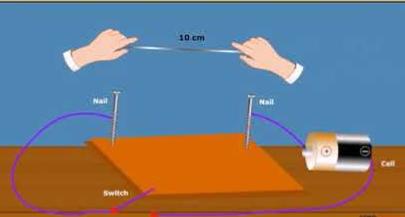
Wires made from some special materials melt quickly and break when large electric currents are passed through them. These materials are used for making electric fuses which prevent fires and damage to electric appliances. When an electric current flows through a wire, it behaves like a magnet.
Symbols of electric components
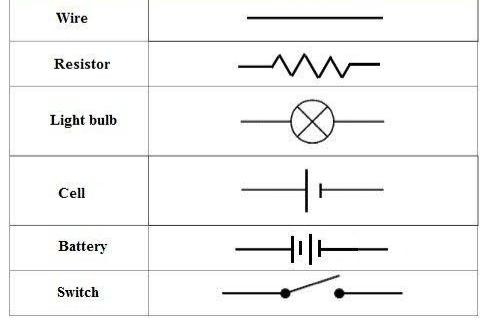
Heating Effect of Electric Current
Heating effects of electric current
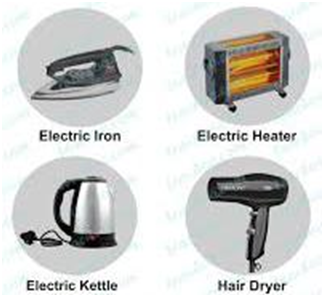
Magnetic Effect of Electric Current
Magnetic effect of electric current
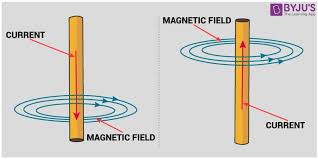
Electric current has two effects; heating effect and magnetic effect. This happens because a magnetic field is generated around the wire as electric current passes through a conductive wire. The magnetic field causes the magnetic compass to deflection.
Electromagnet
Electromagnetic
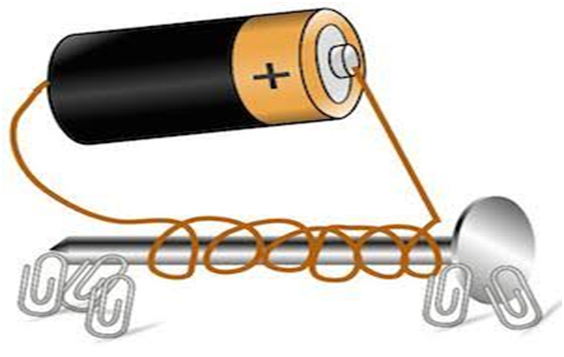
Electromagnetism is a branch of physics involving the study of the electromagnetic force, a type of physical interaction that occurs between electrically charged particles. The electromagnetic force is carried by electromagnetic fields composed of electric fields and magnetic fields, and it is responsible for electromagnetic radiation such as light. It is one of the four fundamental interactions (commonly called forces) in nature, together with the strong interaction, the weak interaction, and gravitation. At high energy, the weak force and electromagnetic force are unified as a single electroweak force.
Electric Bell
Electric Bell
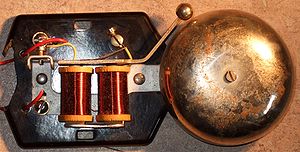
An electric bell is a mechanical or electronic bell that functions by means of an electromagnet. When an electric current is applied, it produces a repetitive buzzing, clanging or ringing sound. Electromechanical bells have been widely used at railroad crossings, in telephones, fire and burglar alarms, as school bells, doorbells, and alarms in industrial plants, since the late 1800s, but they are now being widely replaced with electronic sounders. An electric bell consists of one or more electromagnets, made of a coil of insulated wire around an iron bar, which attract an iron strip armature with a clapper.

 Param Publication
Param Publication
 Grow Career Publication
Grow Career Publication
